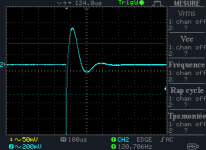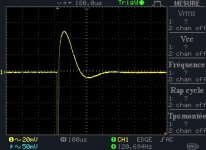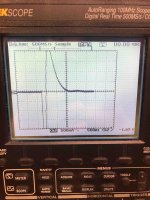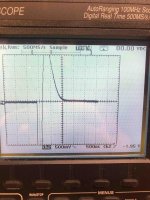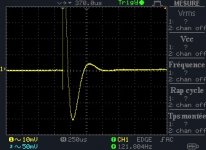Antek AS-3220 115V 400VA 20x2
Cs: 0.15uF
Cx: 0.01uF
RS 16.1R
Antek AS-4222 115V 400VA 22x2
Cs: 0.15uF
Cx: 0.01uF
RS 16.8R
I did two of these they were almost identical
Cs: 0.15uF
Cx: 0.01uF
RS 16.6R
I didn't have that resistor and dropped in a 15R in the Quasi and it was fine there, so I'm using 15R nest size up was 18R and it looked to flat on the initial ring.
Cs: 0.15uF
Cx: 0.01uF
RS 16.1R
Antek AS-4222 115V 400VA 22x2
Cs: 0.15uF
Cx: 0.01uF
RS 16.8R
I did two of these they were almost identical
Cs: 0.15uF
Cx: 0.01uF
RS 16.6R
I didn't have that resistor and dropped in a 15R in the Quasi and it was fine there, so I'm using 15R nest size up was 18R and it looked to flat on the initial ring.
Last edited:
Antek AS-3220 115V 400VA 20x2
Cs: 0.15uF
Cx: 0.01uF
RS 16.1R
Antek AS-4222 115V 400VA 22x2
Cs: 0.15uF
Cx: 0.01uF
RS 16.8R
I did two of these they were almost identical
Cs: 0.15uF
Cx: 0.01uF
RS 16.6R
I didn't have that resistor and dropped in a 15R in the Quasi and it was fine there, so I'm using 15R nest size up was 18R and it looked to flat on the initial ring.
Is the AS-3220 listed above supposed to be a AS-4220 (TYPO) ?
Transformers measured in various Hafler amps using standard capacitor values:
- Hafler XL-280: Dual secondaries each with 2 leads, (high current and low current) giving DC rails of +/- 65VDC and 75 VDC respectively. (All secondaries measured approximately the same.)
Cx = 0.01 uF
Cs = 0.15 uF
Rs = 12 Ω
Cs = 0.15 uF
Rs = 12 Ω
- Hafler DH-500: Single secondary with CT yielding DC rails +/-90 VDC
Cx = 0.01 uF
Cs = 0.15 uF
Rs = 65 Ω
Cs = 0.15 uF
Rs = 65 Ω
- Hafler DH-200: Single secondary with CT yielding DC rails +/-60 VDC
Cx = 0.01 uF
Cs = 0.15 uF
Rs = 39 Ω
Cs = 0.15 uF
Rs = 39 Ω
toroidy
TTSAS0100 - SUPREME AUDIO grade V2-
100VA
Input voltage : 220/230v
Output voltage: 20 V(only one secondary)
Cx=10 nF
Cs=150 nF
R= 36.95 Ω...but after 2/3 hours this value was 34.90 Ω
TTSAS0100 - SUPREME AUDIO grade V2-
100VA
Input voltage : 220/230v
Output voltage: 20 V(only one secondary)
Cx=10 nF
Cs=150 nF
R= 36.95 Ω...but after 2/3 hours this value was 34.90 Ω
Hope the attached table will also be of use.
Originally posted a while ago in the Quasimodo thread:
Simple, no-math transformer snubber using Quasimodo test-jig
Regards,
Braca
Originally posted a while ago in the Quasimodo thread:
Simple, no-math transformer snubber using Quasimodo test-jig
Regards,
Braca
Attachments
Is the AS-3220 listed above supposed to be a AS-4220 (TYPO) ?
Yes and no, good catch btw. The model is correct, however it should read 300VA not 400VA.
In other words:
Antek AS-3220 115V 300VA 20x2
Cs: 0.15uF
Cx: 0.01uF
RS 16.1R
JT
Last edited:
Yes and no, good catch btw. The model is correct, however it should read 300VA not 400VA.
In other words:
Antek AS-3220 115V 300VA 20x2
Cs: 0.15uF
Cx: 0.01uF
RS 16.1R
JT
Ok, thanks much!
- Hafler P-230: Single secondary with CT yielding DC rails +/-65 VDC
Cx = 0.01 uF
Cs = 0.15 uF
Rs = 29 Ω
(Both sides measured the same R, see below)
Note: I'm not positive this is the same type of transformer used in DH-220, but I think it likely is.
Cs = 0.15 uF
Rs = 29 Ω
(Both sides measured the same R, see below)
Note: I'm not positive this is the same type of transformer used in DH-220, but I think it likely is.
- Hafler DH-200: Single secondary with CT yielding DC rails +/-60 VDC (I measured 3 different Hafler DH-200 amps, they all yielded similar results)
Cx = 0.01 uF
Cs = 0.15 uF
Rs = 35 Ω
Note: I consistently obtained a slightly different result for R when I measured the 2nd secondary (against CT) vs. the 1st secondary. The results for each were 40 Ω vs. 28 Ω. So I think 35 Ω is an OK value for either side.
Ron
Cs = 0.15 uF
Rs = 35 Ω
Note: I consistently obtained a slightly different result for R when I measured the 2nd secondary (against CT) vs. the 1st secondary. The results for each were 40 Ω vs. 28 Ω. So I think 35 Ω is an OK value for either side.
Ron
Last edited:
Antek AS-4224 - 400VA, 24V secondaries
Cs: 0.15uF
Cx: 0.01uF
RS 13.7R
In the spirit of DIY, using what I have, the best result I could get was two parallel 26R resisters, which actually measured 13.7R in practice.
Cs: 0.15uF
Cx: 0.01uF
RS 13.7R
In the spirit of DIY, using what I have, the best result I could get was two parallel 26R resisters, which actually measured 13.7R in practice.
Schotty?
Hi Team.
Are all these snubber value results based on using a schotty diod rectifier solution or can the same snubber numbers be used if using a standard bridge rectifier?
Hi Team.
Are all these snubber value results based on using a schotty diod rectifier solution or can the same snubber numbers be used if using a standard bridge rectifier?
The results posted here were all generated with the transformer secondary winding under test connected to the Quasimodo or Cheapomodo test jigs, while all other primary and secondary windings were shorted. A rectifier of any kind was not involved as the test jig itself provides the ringing stimulus.
There's a separate thread detailing the test jig function and a paper about theory of the topic as well as the snubber optimisation method.
Greetings,
Winfried
There's a separate thread detailing the test jig function and a paper about theory of the topic as well as the snubber optimisation method.
Greetings,
Winfried
Selectronic R-Core 230V primary dual 9V secondary 30VA, measurement with two secondaries in parallel
Cx 10nF
Cs 150nF
Rs 82Ω
Cx 10nF
Cs 150nF
Rs 82Ω
Here are my measurements with the Quasimodo SMD. I confirmed it was working correctly using a measured 2.98 mH inductor. Sorry for the images of the results, the scope is old and I couldn't get the capture software to work yet.
Antek AS-4225: 115V primary (shorted), dual 25V secondaries (1 secondary shorted, measured the other) - First image
Cx 10nF
Cs 150nF
Rs 11.8Ω
Triad VPM18-1390: 120V primary (shorted), dual 9V secondaries (1 secondary shorted, measured the other) - Second image
Cx 10nF
Cs 150nF
Rs 16Ω
Amveco 70064K: 115V primary (shorted), dual 18V secondaries (measured in series) - Third image
Cx 10nF
Cs 150nF
Rs 107.9Ω
Antek AS-4225: 115V primary (shorted), dual 25V secondaries (1 secondary shorted, measured the other) - First image
Cx 10nF
Cs 150nF
Rs 11.8Ω
Triad VPM18-1390: 120V primary (shorted), dual 9V secondaries (1 secondary shorted, measured the other) - Second image
Cx 10nF
Cs 150nF
Rs 16Ω
Amveco 70064K: 115V primary (shorted), dual 18V secondaries (measured in series) - Third image
Cx 10nF
Cs 150nF
Rs 107.9Ω
Attachments
- Home
- Amplifiers
- Power Supplies
- Quasimodo results (ONLY)
